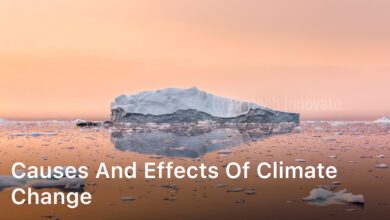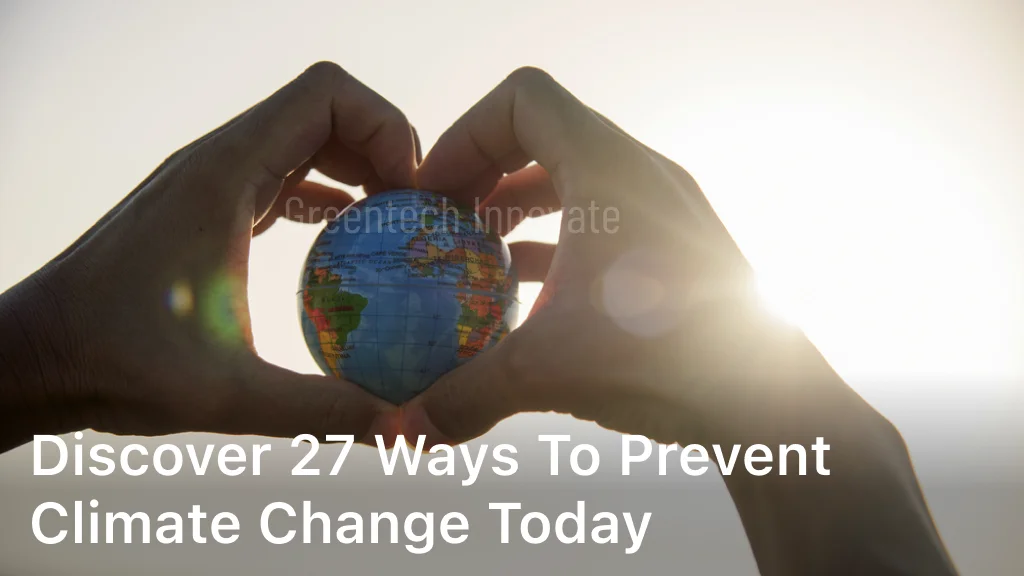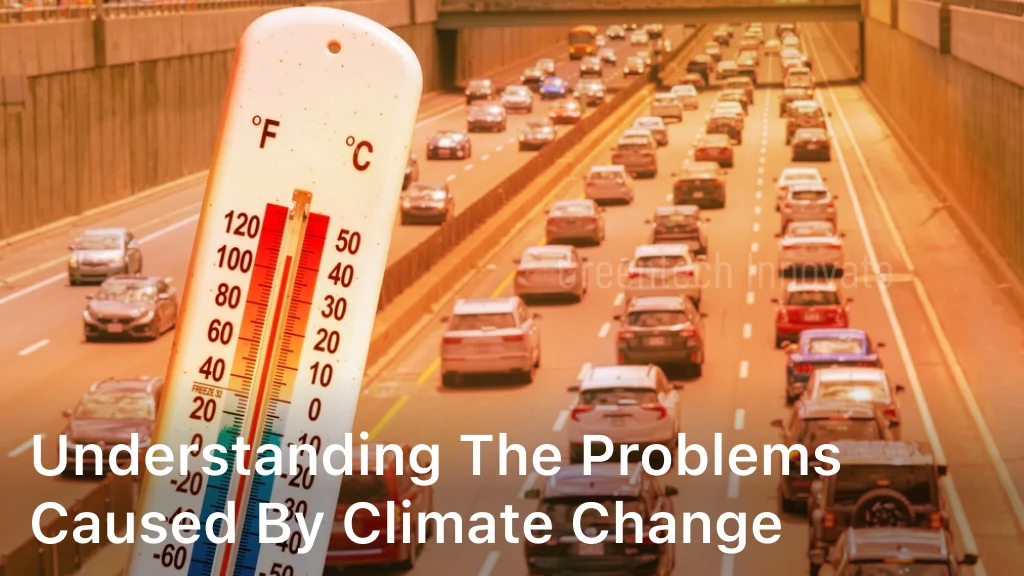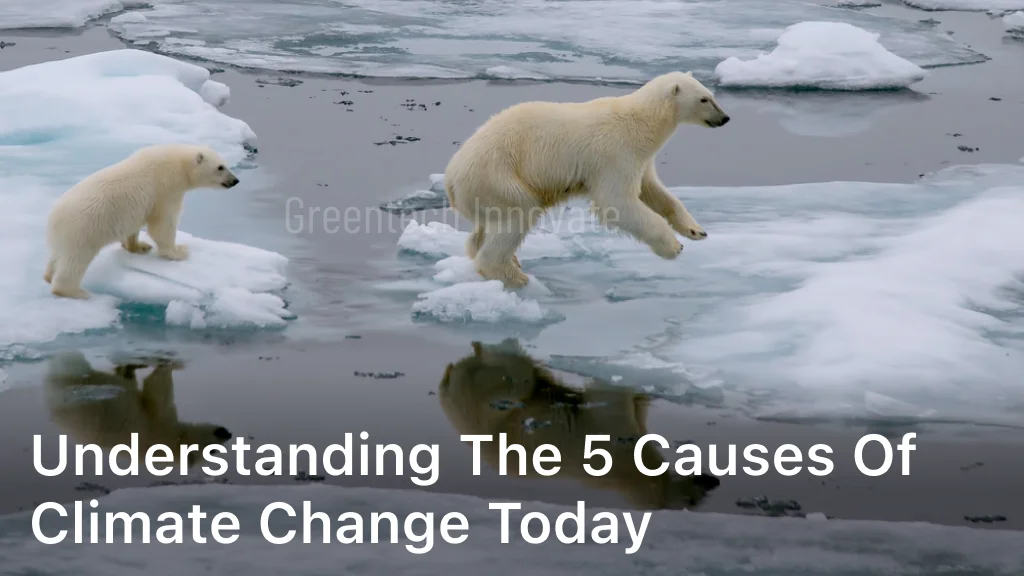
How Does Climate Change Affect the Environment? The impacts of climate change are serious and widespread. Earth’s temperatures have gone up by 1.98°F (1.1°C) since 1901. This warming trend continues and has serious effects.
It causes rising sea levels, changes in weather, like drought and flooding, and more. These changes affect the systems we rely on for our well-being.
It affects areas such as water, energy, transportation, wildlife, agriculture, and ecosystems. For example, a drought can harm food production and human health. On the other hand, flooding can spread diseases and harm critical infrastructure.
The impact of climate change is not the same for everyone. Underserved communities and those with fewest resources suffer the most. While 2020 saw a brief drop in greenhouse gas emissions due to the pandemic, carbon dioxide and methane levels kept rising. This shows we need to act fast to reduce our environmental impact.
We are facing the serious effects of global warming. It is clear that we must act together. We need to prevent the worst outcomes and work towards a sustainable future.
The time for action is now. We need to act to avoid more severe and irreversible impacts of climate change.
Understanding Climate Change
We are exploring the complex nature of our changing climate. It’s key to look at what’s causing this worldwide change. The global temperature rise over the last century is a critical part. It’s caused major shifts in weather, making things like droughts, hurricanes, and floods stronger and harder to predict.
Global Temperature Rise
Since 1901, global temperatures have gone up about 1.8°F (1°C). This change has already been big, making scientists worry. They think we could see temperatures go up a lot more by 2100, like a worst-case jump of 4°C (7.2°F). This could happen if we don’t tackle the main cause of climate change – the burning of fossil fuels.
Causes of Climate Change
Climate change is mainly caused by the release of greenhouse gases. These gases, like carbon dioxide and methane, come from burning fossil fuels, deforestation, and some farming methods. They trap heat, warming the planet and messing up its natural balance.
Interrelated Impacts
The effects of climate change are big and far-reaching. For instance, as the world gets hotter, more water evaporates. This leads to worse and more common droughts, starting a cycle. Droughts dry out the soil and reduce plants, which makes the evaporation happen even faster. This chain reaction shows how complicated and connected the climate issue is.
Rising Sea Levels
As the planet gets hotter, the ice caps are melting and ocean water is getting warmer. This makes sea levels rise quickly. If we don’t cut down on greenhouse gases soon, sea levels could go up by about 6.6 feet by the end of this century. But even a smaller increase, like 1 foot by 2050, could be really bad for coastal areas.
Coastal Erosion
More water means more erosion on coasts. Waves and tides are eating away at the land. This can ruin or wash away houses, businesses, and vital structures close to the shore. People living on the coast are always under the threat of losing their homes and land as the sea moves closer.
Saltwater Intrusion
As the sea rises, it can seep into the ground below, mixing with fresh water. This makes drinking water salty and unfit for crops. Coastal communities, that depend on the fresh water beneath them, face huge risks.
Threats to Coastal Communities
Rising seas, erosion, and salty water are a major danger to coastal towns and cities. Nearly a quarter of Bangladesh is very close to sea level, which shows how bad it can get. In America, places along the coast will see a lot of damage. This includes roads, sewage plants, and power stations as the sea climbs higher.
Extreme Weather Events
As the Earth gets warmer, extreme weather like hurricanes is becoming more common and severe. Warmer air can hold more water, which makes storms wetter and stronger. Hurricane Harvey in 2017 was a deadly example. It dropped a record amount of rain on Houston, causing many deaths.
Intense Hurricanes
Coastal areas face a big danger from more powerful hurricanes. These storms bring strong winds, high water, and lots of rain. The warming oceans mean hurricanes can get stronger fast. This makes predicting and preparing for them harder than before.
Severe Droughts
Higher temperatures also mean more water evaporates, leading to severe droughts. The American West is facing its driest period in over a thousand years. This has hurt farming, water supplies, and the environment badly.
Flooding and Heavy Precipitation
At the same time, heavy rains and flooding are getting worse due to climate change. For every degree the Earth warms, extreme rainfall events get 7% stronger. This can cause a lot of problems, like damaging buildings and roads. It can even be dangerous for people.
how does climate change affect the environment
Climate change is affecting ecosystems all around the globe, from the Arctic to the tropics. The Arctic, in particular, is warming up twice as fast. This leads to rapid ice melting and rising sea levels.
As ice melts, it exposes dark water, which absorbs more sun. This speeds up the melting process. Rising sea levels can harm coastal areas and push into freshwater.
Impact on Ecosystems
The environment is under strain from warmer temperatures and changing rainfall. This stress causes animals and plants to move. It also brings more pests and diseases, disrupting life cycles.
Because these changes are happening quickly, many species can’t keep up. This leads to a loss of different types of living things, which is bad for environments.
Loss of Biodiversity
Animals and plants that are vital for keeping ecosystems balanced face big risks from climate change. This leads to a significant worldwide drop in different types of life.
Ecosystem Disruption
The severe effects of climate change can throw natural systems off balance. This can seriously harm planet health and resilience. It highlights the need to tackle climate change at its source.
Effects on Water Resources
Climate change greatly impacts the world’s water resources. Warmer temperatures make water evaporate faster. This causes severe and lasting droughts, especially in the American West. Here, a “megadrought” has dried up the land for the driest 22 years in over 1,200 years. This is reducing drinking water, hurting crops, and inviting more bugs to our forests.
Diminishing Freshwater Supplies
Warmer temperatures also mean less snowpack overall. The snow that does fall, melts earlier in the year. This disrupts a key source of fresh water for many areas. Places that need the snowmelt during dry summer months are facing challenges. This situation is a problem for farming, keeping ecosystems in balance, and for people to drink.
Snowpack Reduction
The impact of climate change on water is wide-reaching. Places in the American West are particularly feeling the effects. As droughts get worse and the way snow melts changes, we face a water crisis. Conserving water and planning for its sustainable use are key to having enough for the future.
Impact on Agriculture
Climate change is making farming harder and more unpredictable. It’s changing the rain patterns, leading to more droughts and floods. This shifts can seriously hurt what we grow and raise, like causing the death of many cows in Kansas in 2022. The world’s food supply is at risk, and billions might suffer from not having enough to eat.
Crop Yield Reduction
The world’s crop yields are dropping because of these changes. Droughts and floods can wipe out crops. And the warm weather and different rain patterns help pests and diseases spread, making it tough for farmers to grow enough food.
Livestock Vulnerability
Animals are also feeling the heat of climate change, literally. Extreme heat, like the Kansas 2022 heat wave, can kill many livestock. Changes in what they eat and drink, along with more diseases, are hurting their health and how much they can produce. This is bad news for those who depend on raising animals for a living.
Food Security Challenges
The global food supply is facing major problems because of climate change. Less food and unstable prices make it hard for some people to get the nutrition they need. We need to help farmers use better, sustainable ways of farming. Doing this will help ensure everyone has enough to eat.
Ocean Acidification
The climate crisis is hitting the oceans hard. They soak up 93% of the Earth’s excess heat and about 30% of its CO2 from fossil fuels. This makes the oceans warmer and more acidic. Both of these changes are very bad for marine life.
Coral Reef Degradation
As the waters heat up, we see more extreme marine heat waves. These kill off plankton and sea mammals. Ocean acidification also changes the ocean’s chemistry. This makes it hard for creatures like corals to make their shells.
With all these problems, coral reefs suffer a lot. Their slow destruction is harmful to thousands of marine species. It’s also bad for the whole ocean.
Marine Ecosystem Disruption
Ocean acidification and warmer temperatures are messing up marine life. This hits the people who live by the sea hard. They depend on the ocean for food and jobs. We must act fast to protect our oceans.
Human Health Implications
Climate change is affecting our health in many ways. Extreme heat is very dangerous, becoming more common with rising global temperatures. This change affects people differently, especially the elderly, outdoor workers, and those in poor areas. They are more likely to suffer from heat-related illnesses such as exhaustion and heart attacks.
Heat-Related Illnesses
The earth getting warmer means more problems for our health. Long exposure to extreme heat is bad for us, often leading to severe health issues like heatstroke. This is a big problem for those who have to work outside or can’t cool down their homes.
Spread of Infectious Diseases
Diseases carried by mosquitoes and ticks are moving to new places due to climate change. These insects now find more areas suitable for them to live and reproduce, bringing diseases with them. New places might start seeing diseases they’ve never faced before.
Air Quality Issues
Climate change harms air quality in ways that can make breathing harder. Ozone from the ground and wildfire smoke can make asthma and lung problems worse. These problems hit already struggling communities the hardest. We need to work on public health and preparing for climate change to protect everyone.
Infrastructure Risks
Climate change is a big danger to our society’s key systems, like transport, communication, and energy. Events like storms can harm these systems. Plus, the ocean is rising, putting roads, bridges, and other vital infrastructures at risk.
Coastal Infrastructure Vulnerability
About 40% of Americans live near the coast. This puts them and vital structures at risk from sea level rise and erosion. If these areas are damaged, essential services could be heavily impacted.
Transportation System Impacts
Heavy rain and floods can close roads, disturbing the flow of goods and people. Higher temperatures also place a strain on our transportation systems, which need more cooling. This can make things even tougher to manage.
Energy Grid Challenges
Climate change is also threatening our energy systems. More heat means more cooling is needed, taxing the system further. Weather extremes can break power plants and lines, causing power cuts. Unfortunately, these issues hit those already in a tough spot the hardest.
Climate Mitigation Strategies
Experts are worried about the future if we don’t act on climate change now. But, they also believe we can make things better if we act fast. To do this, we need to stop the Earth from getting too warm. We should reduce how much greenhouse gas we make, aiming for none.
This will mean spending a lot on new ways to make energy. We should use more solar and wind power instead of burning fossil fuels.
Reducing Greenhouse Gas Emissions
To cut down on greenhouse gases, we must change how we do things in areas like transportation and making goods. We can do this by making rules that encourage using clean energy. Also, we should try to use less energy overall and make new, clean tech.
Sustainable Energy Solutions
Using clean energy, like power from the sun, wind, and water, is key to fighting climate change. We need to put more money into things like solar panels and better power grids. Doing this will help us stop using so many fossil fuels and lower our emissions.
Adaptation and Resilience Measures
It’s not enough to just try and stop climate change. We also need to get ready for its effects and make sure we can bounce back from bad events. This means doing things like making our coasts stronger against storms and making sure we’re ready when bad weather is coming.
By preparing for the future and trying to stop climate change, we protect our planet and our homes.

Conclusion
Climate change is a serious issue that’s already affecting us and our planet. It leads to higher temperatures and rising seas, causing more extreme weather. Also, it harms our ecosystems and food production. This has environmental, health, and food safety impacts.
But, we still have a chance to make things better. We can lower harmful gas emissions and use clean energy more. Plus, we can adapt to these changes to protect our future. The issue is critical now for our planet and everyone living on it.
The summary highlights crucial points from the article about climate change and its effects. We must all act to fight climate change. It affects our environment, health, and food globally. By working together, we can create a better future for everyone.




